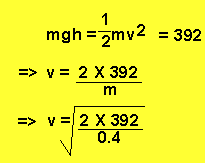gravitational into kinetic
Heavy objects raised high above the ground contain a great deal of gravitational potential energy. As they are released, this energy often is converted into kinetic energy as the objects increase in speed as they fall. The law of Conservation of Energy states that "Energy can not be created or destroyed". So that means that, in an ideal situation with 100% energy efficiency, all the gravitational potential energy is converted into kinetic energy as an object falls.
The video on the right shows the energy of a wrecking ball and a water fall. Water raised to high levels can be used to ultimately generate electrical energy in hydro-electric powerstations.
Lets work on some examples
A roller coaster is a classic example of conversion of kinetic energy into gravitational potential and gravitational potential into kinetic energy. Look at the animation on the right. We assume no energy is lost from the system. Notice how at the very top of the roller coaster the ball has all energy in the form of gravitational potential. As it falls gravitational energy is steadily converted into kinetic energy. At the bottom of the roller coaster all energy is in the form of kinetic energy. Notice in the animation on the right the total amount of energy is always constant, it just changes form.
The ball has maximum speed at the bottom of the roller coaster. This is where all the potential energy is converted into kinetic energy. At the top of the roller coaster the ball is at its maximum height and therefore has maximum potential energy.


Example 1) A 400g cart sits
100m above the ground. It rolls off the edge and drops to ground level
(point "A") along a roller coaster track.
a) Calculate the kinetic and gravitational potential energies of the cart
at point "A"
The cart starts
of with all its energy in the form of gravitational potential energy.
mgh = 0.4 X 9.8 X 100 = 392 joules.
As it rolls down the track gravitational potential energy is slowly converted
to kinetic energy. At ground level (point "A") all the energy
is now converted into kinetic and the expression below is true.

Click to see how the gravitational potential and the kinetic energies change.
Since the height
of the cart at "A" is zero its gravitational energy is zero.
Since we have 100% conversion, the kinetic energy is equal to the gravitational
potential energy the cart started with.
Kinetic energy = 392
joules.
b) What is the
speed of the cart at point "A"
Since all the energy is in the form of kinetic the expression below is
true and we solve for "v".

v = 44.27 m/second